“To infinity and beyond!” Buzz Lightyear’s famous line resonates with the human desire to explore the vast expanse of space. And what better destination to set our sights on than Mars, the enigmatic red planet? But before we pack our spacesuits and book our tickets, one burning question arises: How Long Is The Travel To Mars?
Decoding the Martian Itinerary: It’s Not Just a Straight Shot
Unlike a road trip from New York City to the Grand Canyon, the journey to Mars is far from a straight line. Both Earth and Mars dance around the sun in elliptical orbits, with their relative positions constantly shifting. This celestial ballet means the distance between the two planets is constantly changing, making a one-size-fits-all answer to our question impossible.
Factors Influencing Travel Time: A Cosmic Balancing Act
The journey duration hinges on several key factors:
- Planetary Alignment: Like catching a moving train, launching a spacecraft when Earth and Mars are closest together – a phenomenon known as opposition – significantly shortens the travel time. This optimal alignment occurs approximately every 26 months.
- Propulsion Systems: Imagine cruising down the highway; a powerful engine will get you there faster. Similarly, advanced propulsion systems like ion propulsion or nuclear thermal rockets could drastically reduce travel time compared to traditional chemical rockets.
- Trajectory: Taking the scenic route might be enjoyable on Earth, but in space, efficiency is key. Hohmann Transfer Orbit, a fuel-efficient trajectory, is commonly used for Mars missions.
The Expected ETA: A Range, Not a Date
Based on current technology and understanding, a one-way trip to Mars is estimated to take around 7-9 months. However, remember that this is just one leg of the journey. A round-trip mission, including time spent on the Martian surface, would significantly extend the duration, potentially lasting over two years.
Embracing the Challenges: A Test of Human Endurance
Such a prolonged space voyage presents unique challenges for astronauts, including:
- Psychological Impact: Spending months confined within a spacecraft, far from Earth, can take a toll on mental well-being.
- Radiation Exposure: Beyond Earth’s protective atmosphere, astronauts face increased exposure to harmful cosmic radiation, posing health risks.
- Physiological Adaptations: Prolonged exposure to microgravity can weaken muscles and bones, requiring rigorous exercise regimens to mitigate these effects.
Planning Your Martian Adventure? What to Pack (Metaphorically, of Course)
While commercial flights to Mars might still be a distant dream, let’s indulge in a bit of hypothetical planning. What should you pack for this extraordinary adventure?
- Patience: The journey is long, and delays are always a possibility. Embrace the opportunity to connect with your crewmates and marvel at the cosmos.
- Adaptability: Things won’t always go according to plan. Being flexible and resourceful is key to navigating the unexpected.
- A Sense of Wonder: You’re embarking on a journey to another planet! Never lose your sense of awe and appreciation for the vastness and beauty of the universe.
Travelcar.edu.vn: Your Guide to Earthly Adventures
While we navigate the complexities of interplanetary travel, why not explore the wonders our own planet has to offer? Travelcar.edu.vn provides a wealth of information and inspiration for your next adventure, from the bustling streets of Tokyo to the serene landscapes of Iceland.
 Mars Rover
Mars Rover
Frequently Asked Questions about Traveling to Mars
How much would it cost to travel to Mars?
The cost of a Mars mission is astronomical, literally! Estimates for sending humans to Mars range from tens to hundreds of billions of dollars, depending on the mission’s complexity and technology used.
Is it safe to travel to Mars?
Traveling to Mars poses significant risks due to radiation exposure, the challenges of prolonged spaceflight, and the harsh Martian environment. Ensuring astronaut safety is paramount, and extensive research and development are underway to mitigate these risks.
Will we ever be able to live on Mars?
While establishing a permanent human colony on Mars remains a distant goal, it’s a possibility that scientists and engineers are actively exploring. From developing sustainable habitats to terraforming the planet, the challenges are immense but not insurmountable.
Conclusion
The question of “how long is the travel to Mars?” doesn’t have a simple answer. It’s a complex equation with variables constantly in flux. But one thing is certain: the human spirit of exploration will continue to push the boundaries of possibility, propelling us towards the red planet and beyond. In the meantime, let’s cherish the wonders of our own planet and nurture the spirit of adventure within us.
 Astronaut on Mars
Astronaut on Mars
Feel free to share your thoughts, questions, and dreams of space travel in the comments below! And for those seeking adventure closer to home, visit travelcar.edu.vn for travel inspiration and guidance.